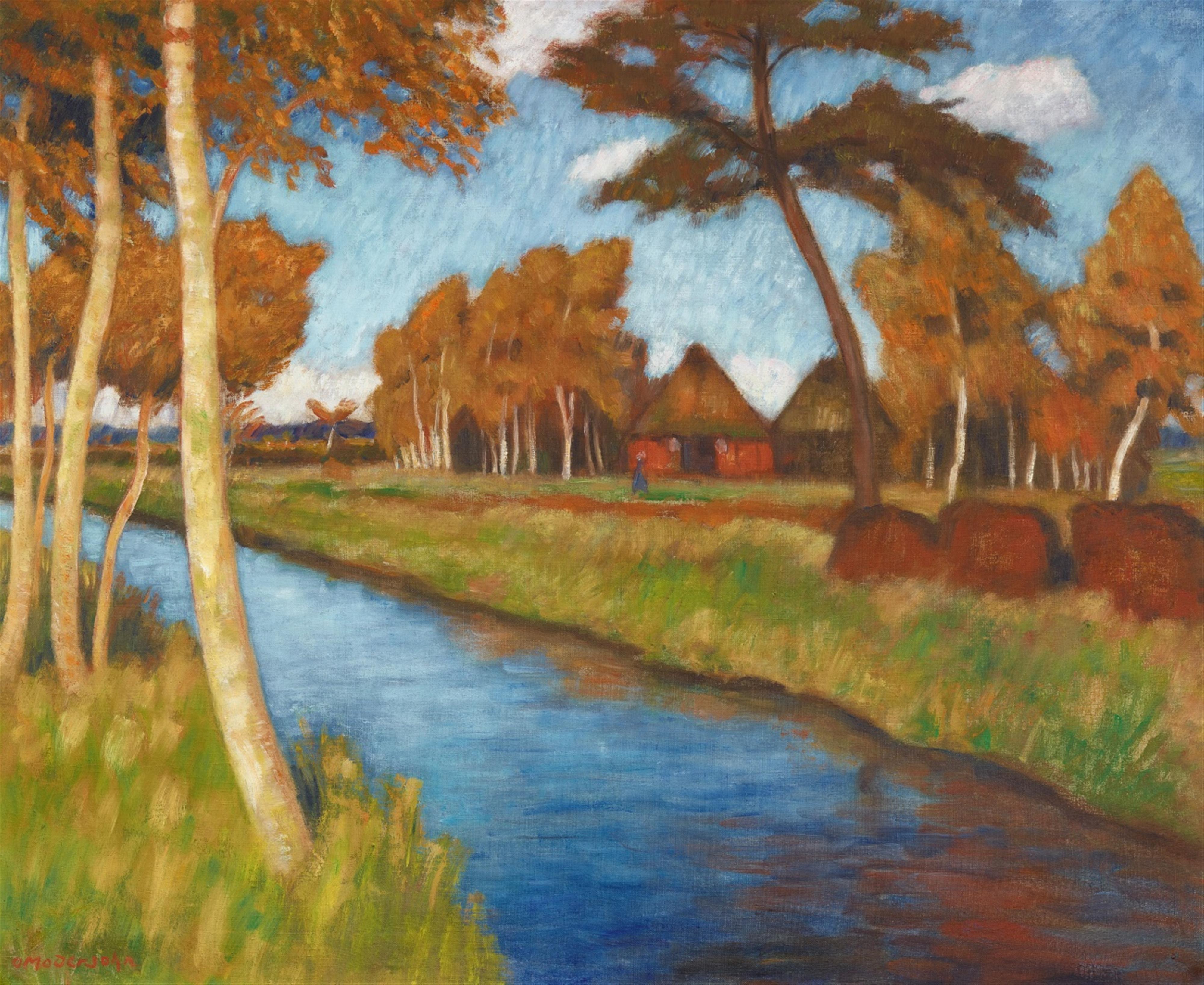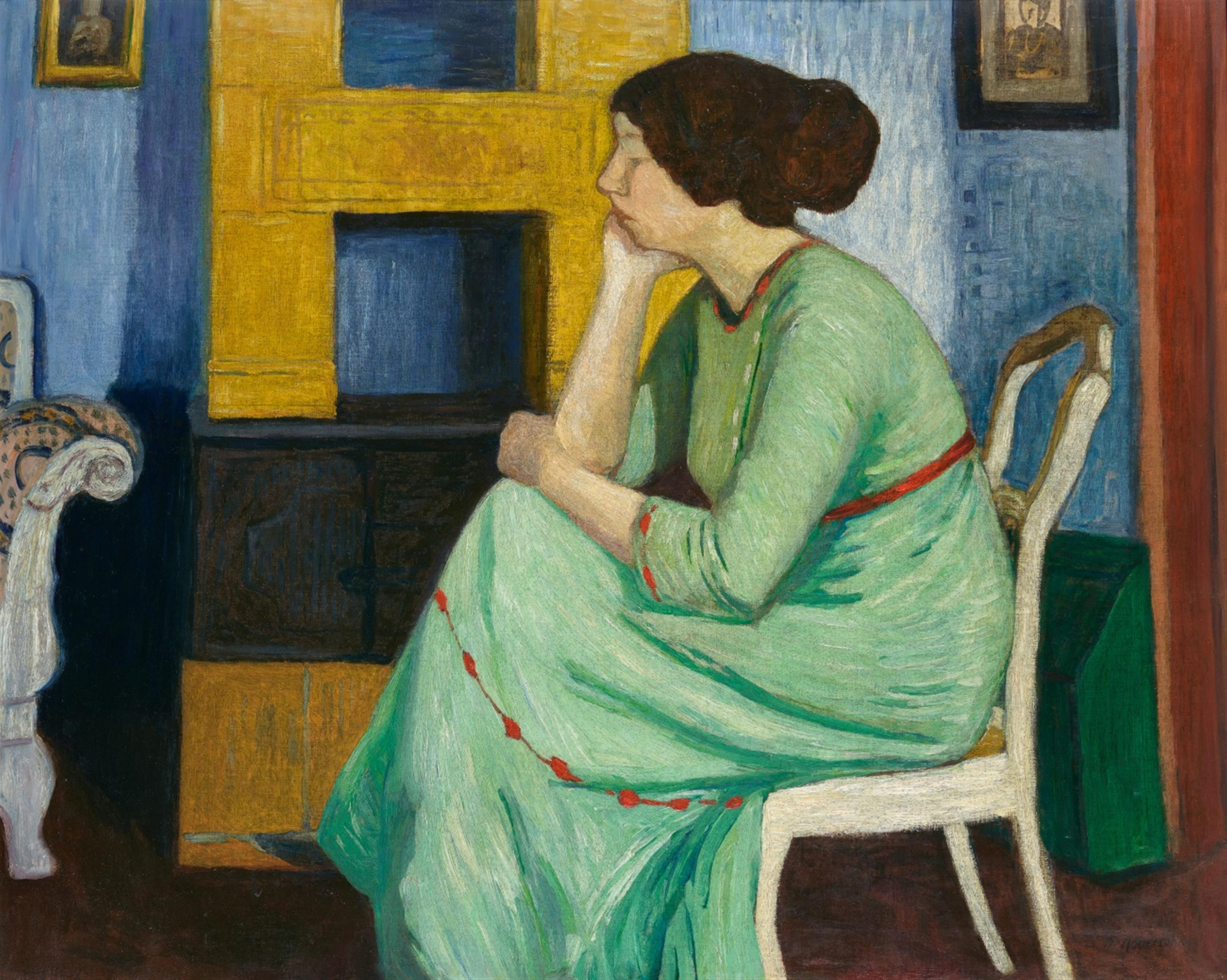Otto Modersohn
Herbst am Moorkanal. Verso: Louise Modersohn-Breling im grünen Kleid
1923/1913
Oil on canvas 74 x 90 cm resp. 73 x 92 cm Framed on both sides. Signed 'OModersohn' (joined) in reddish brown lower left, remnants of a crossed out signature to the right as well as signed verso 'O Modersohn' in black lower right. - Professionally restored. The rear side of painting revealed.
This landscape later painted on the back of the portrait of Louise Modersohn-Breling is captivating in its vitality and expansiveness within its horizontal format - the clear air of the area surrounding Bremen in North Germany almost seems to blow out against us. The red-orange and brown tones of the autumnal vegetation and the huts nestled into the landscape form a bold contrast to the light blue of the sky. Cottony, soft contours convey a sense of lightness, but they are nonetheless able to provide the composition with a down-to-earth steadfastness and depth. This composition is dynamised through the diagonal course of the fen canal.
Otto Modersohn, who grew up in Soest and Münster, came to Worpswede in the summer of 1889, and the village and its surroundings became his main theme, with every variation on its motifs and times of day and the year. In his journal, Otto Modersohn describes his first impression: “I found a highly original village that made a thoroughly foreign impression on me […], the large moss-covered straw roofs, and in every direction, as far as you could see, always the same expansiveness as along the sea.” (Otto Modersohn, Journal, 3 July 1889, cited in exhib. cat., Otto Modersohn. Fischerhude 1908-1943, Fischerhude 1993, pp. 287 f.). In the year this landscape was created, the painter described his new insight: “Simplicity, simplification is the most important thing, not just in the form, but even more so in the colour. The picture must represent an accord, a harmony. […] Everything depends on a picture's being 'strong'” (O.M., Journal, 10 Sept 1923, cited in ibid., p. 110). These new principles come to bear in the Worpswede landscape offered here: Otto Modersohn has achieved a strong and convincing composition in a luminous colour scheme which radiates a sense of optimistic calm.
What was formerly the front of this canvas, which is painted on both sides, presents a portrait of the singer Louise Modersohn-Breling, who married the twice-widowed painter in 1909. Otto Modersohn has depicted his wife in an almost abstract manner: outlined in profile, he has invested her with an ornamental character adhering to the principles of art nouveau. Fitted into the three-dimensional rectangle of the space, she almost entirely fills the sitting room. However, beyond the expected qualities of hearth and home, which are perhaps commemorated here, the artist has also depicted Louise in terms of a woman endowed with intellectual qualities. Since antiquity the gesture of figures resting their head on one hand has been a traditional one for various muses who, as ancient sculptures, were part of the canon of classic academic training - which Modersohn also completed. The painter presumably also re-encountered this succinctly evocative pose at that time, during his stay in Paris, in Rodin's depiction of The Thinker.
Catalogue Raisonné
In studio book winter 1923/1924: 4) as "Herbstlandschaft Kanal n. Komp. 91 x 73". Verso studio book winter 1912/1913: "L. grün vor Ofen 92 x 73"
Certificate
With a certificate by Rainer Noeres, Otto Modersohn Museum, Fischerhude, dated 19 Sept. 2019
Provenance
Acquired directly from the artist by the previous owner; in family possession, South Germany, since
Exhibitions
Fischerhude (Otto Modersohn Museum), loan




